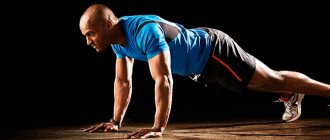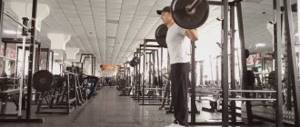Muscle work
Lunges with an elevated supporting leg work the muscles of the front and back of the thighs, and also perfectly work the gluteal muscles. This exercise helps give your legs and buttocks a sculpted, contoured shape.
What muscles work:
- Quadriceps - the front surface of the thigh.
- Large gluteal muscles.
- Biceps hamstrings - posterior surface.
- Stabilizers: gluteus medius and minimus, core muscles.
If you do an exercise with dumbbells, some static load goes to the arm muscles.
Pros of Bulgarian lunges
- the load falls on one leg (alternately), which increases work efficiency;
- the need to maintain balance develops the athlete’s ability to balance the body and develop stabilizing muscles;
- The Bulgarian attack affects the small muscles of the legs;
- the buttocks acquire the desired rounded shape, the hips and legs decrease in volume;
- the cortex muscles develop and strengthen;
- the knee joint is stabilized;
- the athlete jumps and twitches better;
- the presence of the type allows you to select the load individually;
- The exercise is available for home use.
Benefits of Exercise
Bulgarian squats are recommended for athletes who already have training experience. From a technical point of view, the exercise is not the simplest. This is due to the fact that you not only need to do all the work with the muscles of one leg, instead of two, but also maintain balance.
So why do we need all this complexity? What advantages do such lunges provide when training the legs and buttocks, compared to classic lunges and squats?
- As already mentioned, you do all the work with the muscles of the front leg. The only function of the supporting leg is to support you so that you do not fall. This allows you to work the target muscles as efficiently as possible. In addition, you can control the load on your right and left leg. If one leg lags behind, it can be loaded harder.
- Balance training. To maintain balance and still move, you will need to engage a large array of core stabilizer muscles. The skill of maintaining balance will be useful to you in many other exercises.
- Flexibility and mobility of the hip joints develops.
- The gluteal muscles of the working leg receive a good stretch at the bottom of the movement. Accordingly, the amplitude of contraction of these muscles increases, which makes their training more effective.
- During the movement, you do not need to lean your body forward, as in classic squats. This reduces the load on the spine.
Among other things, the exercise is perfect for training at home. It is not demanding on inventory. You can do Bulgarian lunges in front of the TV with your supporting leg on the couch and still get a great workout.
But, in fairness, it is worth citing the disadvantages of this exercise:
- The Bulgarian split squat places increased stress on the knee joint. This disadvantage follows from the first advantage of the exercise - concentrating the weight on one leg. This load is contraindicated for people with knee problems.
- For beginners who have no training experience, it will be difficult to immediately master the technique. In this case, it is better to save the exercise for later.
Bulgarian lunges or split squats can be used to finish off the muscles after barbell squats. They are also well suited for working on terrain. This is more of a formative exercise than a mass-gaining one. It does not use heavy weights.
Other effective squats
Tabata is one of the effective methods of interval training. Tabata was originally invented for training with some intervals of 20 and 10 seconds. A person should work intensely for 20 seconds, and then rest 2 times less. Tabata consists of 8 repeated cycles (total duration of execution - 4 minutes).
Tabata is difficult to perform for beginners and experienced athletes, which is its advantage. The set of exercises includes not only squats, but also jumps and pull-ups. The movements are combined. At home, you can burn off energy by doing aerobic squats. It is suitable in cases where you need to develop sufficient endurance. At the same time, aerobic squats preserve muscle mass.
Plyometric training makes it possible to improve an athlete's power and increase reaction speed . Plyometric actions are carried out at a fast pace, which makes it possible to burn more than 500 kcal at one time. And to improve coordination, Spartan squats, which involve squats on 1 leg, are ideal.
If you do deadlifts, their difference from regular exercises is in the location of the bar. It is held in the hands, and not on the shoulders themselves or behind (in front) of them. Anderson squats, which require the use of a power rack, are also performed with a barbell.
Whichever of the presented squats a beginner chooses, one must always take into account the rules of execution and act in accordance with the provided technique. This will help you achieve success and not harm your health. What type of exercise to choose or what to include in an individual program determines the athlete's goal and physical condition.
Within the walls of the “YourRevolution1905” club, we are ready to professionally help you tighten your body and improve your physical shape. Whole sets of exercises developed by certified specialists, nutritional recommendations, “smart” weighing and much more, all this will help you achieve your goal as effectively as possible. For the most effective and quick results, you can train individually (one-on-one with a trainer) or in mini-groups of up to ten people. Come to our classes and we will help you become the best version of yourself!
Execution technique
Before you begin performing Bulgarian lunges, thoroughly stretch your knee joints. Let's consider the most popular version of the exercise - with dumbbells.
The execution technique looks like this:
- Take dumbbells, go to the bench and stand with your back to it. Take a wide step forward with one foot and place the other on the bench on the top of your foot. Lower your arms with dumbbells along your body. This is your starting position.
- Maintaining a straight body position and a natural arch in your back, squat on your working leg so that its thigh is parallel to the floor. The knee of this leg should not go beyond the line of the toe during a squat. The center of gravity is on the heel of the working leg, but the toe does not come off the floor. The knee of the supporting leg moves down freely.
- Push your heel off the floor and return to the starting position.
Repeat the exercise 10–15 times and change legs. Perform 3-4 sets on each side. If any leg requires special attention, increase the load on it.
Practical tips and advice
Recommendations (technical) for the implementation of the proposed complex:
- perform movements at a slow pace;
- keep your back straight, don’t bend over, look forward and not down;
- maintain an average stride length, without shortening or lengthening;
- Keep the supporting thigh parallel to the floor when lunging;
- do not sharpen the angle of the knee, do not point your toes forward, do not block it when lifting;
- start lifting by pushing off with your heel;
- follow the principle “from simple to complex”: gradually increase the number of repetitions, the weight of dumbbells and the height of the bench.
At first, it is important to maintain balance and then increase the depth of the lunges. When performing lunges with dumbbells, the arm muscles are also given a workout.
If your knee extends beyond your toes when squatting, you should move your leg forward a little further. To achieve maximum results, do not fully extend your knee when lifting; this will increase muscle tension. When squatting, the lower leg must be supported vertically.
If you follow the technique and recommendations, the results will be noticeable after two weeks of systematic training. Moreover, the result can not only be assessed visually, but also physically felt. When implementing the program, the efforts that were evident at the beginning will no longer be needed.
Interesting points
To ensure that your training brings the desired results, pay attention to the following subtleties when performing Bulgarian lunges:
- During squats on your working leg, keep your shin strictly vertical, your knee and toe pointing forward. In this exercise, the anatomical position of the joints is extremely important.
- Balancing with dumbbells is much easier than with a barbell. The load on the spine is also less. You can work with a barbell in a Smith machine, but in other cases you should prefer doing it with dumbbells.
- Use small, or at least medium, weights. When learning the technique, you can generally do without weights or use small dumbbells.
- If your goal is overall leg mass, opt for classic squats and lunges. Use Bulgarian lunges to give your legs and buttocks the ideal shape and texture.
- Keep your back straight, do not lean forward.
By incorporating the Bulgarian-style split squat into your workouts, you can effectively work your legs and butt muscles and give your lower body a beautifully defined shape. Listen to your feelings, get enough rest and make your workouts more productive every day.
Other options
You can build muscle with a barbell using the Hatfield method of squatting, which is considered very effective. The process uses a weight of 40 kg and a special pillow. The barbell must be placed on your back, which eliminates the need to hold the apparatus with your hands. Actions are carried out as long as there is enough strength. It is allowed to allow the body to rest a little between several approaches.
Hatfield squats are essential for maximizing the load on the lower back and knee joints. The exercise does not involve squatting fully, which distinguishes it from the original version. There is a type of plie training. It is aimed at working the inner thighs. This is ensured by correct positioning. Squats are performed with a wide stance of the lower limbs. They should be positioned wider than shoulder width.
The toes on the feet are spread in different directions. Squats are wide, the torso should be positioned in a direction perpendicular to the floor, without leaning forward. High efficiency of movements is noticeable if, during lowering, the hips and shins create an angle of 90°.
Other types: squats with a trap bar, which is good for the back and buttocks (requires the use of a trap bar during the process, which is why they are rarely included in the program), squats in a Smith machine.
For women who want to work their lower thighs, sissy squats are a great option. Since the manipulation is performed at a non-standard angle, movements can be performed without additional loads or with the use of moderate weight. It is possible to increase the weight if the bar is positioned in front of the shoulders or with the arms down, but this is not squats with the weight between the legs (hands should be kept on the sides of the torso).
Execution technique: position of the feet - about 50 cm apart. First you need to rise on your toes, then, while performing a squat, lean back with maximum force. The torso and hips should be in line. When performing this style is difficult, you can hold on to a chair, armchair, or use a rope to help avoid losing your balance.











